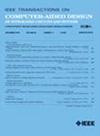Asymmetric and Adaptive Error Correction in STT-MRAM
IF 2.9
3区 计算机科学
Q2 COMPUTER SCIENCE, HARDWARE & ARCHITECTURE
IEEE Transactions on Computer-Aided Design of Integrated Circuits and Systems
Pub Date : 2025-02-12
DOI:10.1109/TCAD.2025.3541188
引用次数: 0
Abstract
Spin-transfer torque magnetic random access memory (STT-MRAM) has emerged as a promising alternative to conventional CMOS memory technologies for on-chip cache replacement. Due to its superior access speeds, high endurance, and scalability, it is being extensively considered a promising candidate for last-level cache replacement. This technology has reached considerable industrial maturity, with several foundries now offering this emerging technology. Despite its advantages, STT-MRAM faces reliability challenges, primarily due to its asymmetric error characteristics during write and read operations, where the likelihood of a bit transitioning fromSTT-MRAM中的不对称和自适应纠错
自旋转移转矩磁随机存取存储器(STT-MRAM)已成为传统CMOS存储技术的一种有前途的芯片上缓存替代方案。由于其优越的访问速度、高持久性和可伸缩性,它被广泛认为是最后一级缓存替换的有希望的候选对象。这项技术已经达到相当大的工业成熟度,现在有几家代工厂提供这种新兴技术。尽管STT-MRAM具有优势,但它面临着可靠性方面的挑战,主要是由于其在写和读操作期间的非对称错误特征,其中从$1\右row 0$转换比特的可能性与从$0\右row 1$转换比特的可能性不同。传统的纠错码(ecc)没有考虑到这些位翻转类型之间的这种不对称性,无法提供平衡的纠错。本文介绍了STT-MRAM中基于数据位的汉明权重的有效非对称和自适应纠错,该纠错与标准ECC框架一起运行,开销可以忽略不计。我们的模拟结果表明,所提出的技术在可靠性方面有了实质性的提高,通过缓存字/块错误率来衡量,在各种SPEC CPU2017基准测试的最后一级缓存数据中进行了测试。这种可靠性的增强是在不插入过多内存和硬件开销的情况下实现的,也不会影响系统性能,这为提高STT-MRAM的操作可靠性提供了一个令人信服的案例。
本文章由计算机程序翻译,如有差异,请以英文原文为准。
求助全文
约1分钟内获得全文
求助全文
来源期刊
CiteScore
5.60
自引率
13.80%
发文量
500
审稿时长
7 months
期刊介绍:
The purpose of this Transactions is to publish papers of interest to individuals in the area of computer-aided design of integrated circuits and systems composed of analog, digital, mixed-signal, optical, or microwave components. The aids include methods, models, algorithms, and man-machine interfaces for system-level, physical and logical design including: planning, synthesis, partitioning, modeling, simulation, layout, verification, testing, hardware-software co-design and documentation of integrated circuit and system designs of all complexities. Design tools and techniques for evaluating and designing integrated circuits and systems for metrics such as performance, power, reliability, testability, and security are a focus.

 求助内容:
求助内容: 应助结果提醒方式:
应助结果提醒方式:


